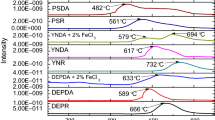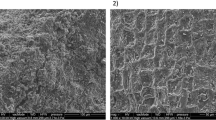Abstract
Brown coal-based materials are excellent adsorbents for reducing chromium(VI) to chromium(III) and afterward immobilizing these chromium(III) by the binding of oxygenic functional groups in adsorbents. In the study, the approach of pyrolysis is employed for the treatment of Cr-loaded solid waste. The effects of adsorbed chromium on the pyrolysis of Xilingol brown coal were studied, and the solid char residues were collected to characterize with XPS, XRD and SEM/EDX. For the pyrolysis in Ar, the mass loss rates of Cr-loaded samples were much higher than that of unloaded samples above 750 °C, together with the increase in CO and H2 emission. XPS spectra revealed that the increase in CO could be related to formation of [Cr–O–C]. For the pyrolysis in CO2, the presence of chromium was more favorable for the conversion of char, especially demineralized brown coal and kerogen. The maximum decomposition temperatures for the Cr-loaded samples were about 200 °C lower than that of unloaded samples. The char residue yields of Cr-loaded samples were obviously higher than that of corresponding unloaded samples (at 1200 °C). Finally, the chromium in the solid residue was recovered in the form of Cr2O3. The present study exploits an approach method for both brown coal waste treatment and chromium recovery.








Similar content being viewed by others
References
Garg UK, Kaur MP, Garg VK, Sud D. Removal of hexavalent chromium from aqueous solution by agricultural waste biomass. J Hazard Mater. 2007;140(1–2):60–8.
Gode F, Atalay ED, Pehlivan E. Removal of Cr(VI) from aqueous solutions using modified red pine sawdust. J Hazard Mater. 2008;152(3):1201–7.
Arslan G, Edebali S, Pehlivan E. Physical and chemical factors affecting the adsorption of Cr(VI) via humic acids extracted from brown coals. Desalination. 2010;255(1–3):117–23.
Prado AGS, Moura AO, Andrade RDA, Pescara IC, Ferreira VS, Faria EA, et al. Application of Brazilian sawdust samples for chromium removal from tannery wastewater. J Therm Anal Calorim. 2009;99(2):681–7.
Zhao T, Ge W, Nie Y, Wang Y, Zeng F, Qiao Y. Highly efficient detoxification of Cr(VI) by brown coal and kerogen: process and structure studies. Fuel Process Technol. 2016;150:71–7.
Zhao T, Ge W, Yue F, Wang Y, Pedersen C, Zeng F, Qiao Y. Mechanism study of Cr(III) immobilization in the process of Cr(VI) removal by Huolinhe lignite. Fuel Process Technol. 2016;152:375–80.
Gode F, Pehlivan E. Chromium(VI) adsorption by brown coals. Energy Sources Part A. 2006;28(5):447–57.
Arslan G, Pehlivan E. Batch removal of chromium(VI) from aqueous solution by Turkish brown coals. Bioresour Technol. 2007;98(15):2836–45.
Arslan G, Pehlivan E. Uptake of Cr3+ from aqueous solution by lignite-based humic acids. Bioresour Technol. 2008;99(16):7597–605.
Gode F, Pehlivan E. Adsorption of Cr(III) ions by Turkish brown coals. Fuel Process Technol. 2005;86(8):875–84.
Pehlivan E, Arslan G. Removal of metal ions using lignite in aqueous solution—low cost biosorbents. Fuel Process Technol. 2007;88(1):99–106.
Uçurum M. A study of removal of Pb heavy metal ions from aqueous solution using lignite and a new cheap adsorbent (lignite washing plant tailings). Fuel. 2009;88(8):1460–5.
Rouff AA. The use of TG/DSC–FT-IR to assess the effect of Cr sorption on struvite stability and composition. J Therm Anal Calorim. 2011;110(3):1217–23.
Luzon M, Corrales T. Thermal studies and chromium removal efficiency of thermoresponsive hyperbranched copolymers based on PEG-methacrylates. J Therm Anal Calorim. 2013;116(1):401–9.
Varitis S, Pavlidou E, Kavouras P, Vourlias G, Chrissafis K, Xenidis A, et al. Devitrification routes of a vitrified chromium-loaded ash. J Therm Anal Calorim. 2015;121(1):203–8.
Wang XJ, Zhu HL, Wang XM, Liu HF, Wang FC, Yu GS. Transformation and reactivity of a potassium catalyst during coal-steam catalytic pyrolysis and gasification. Energy Technol. 2014;2(7):598–603.
Liu QR, Hu HQ, Zhou Q, Zhu SW, Chen GH. Effect of inorganic matter on reactivity and kinetics of coal pyrolysis. Fuel. 2004;83(6):713–8.
Ohtsuka Y, Wu ZH, Furimsky E. Effect of alkali and alkaline earth metals on nitrogen release during temperature programmed pyrolysis of coal. Fuel. 1997;76(14–15):1361–7.
Beamish BB, Shaw KJ, Rodgers KA, Newman J. Thermogravimetric determination of the carbon dioxide reactivity of char from some New Zealand coals and its association with the inorganic geochemistry of the parent coal. Fuel Process Technol. 1998;53(3):243–53.
Quyn DM, Wu H, Li C-Z. Volatilisation and catalytic effects of alkali and alkaline earth metallic species during the pyrolysis and gasification of Victorian brown coal. Part I. Volatilisation of Na and Cl from a set of NaCl-loaded samples. Fuel. 2002;81(2):143–9.
Kabir KB, Tahmasebi A, Bhattacharya S, Yu J. Intrinsic kinetics of CO2 gasification of a Victorian coal char. J Therm Anal Calorim. 2015;123(2):1685–94.
Irfan MF, Usman MR, Kusakabe K. Coal gasification in CO2 atmosphere and its kinetics since 1948: a brief review. Energy. 2011;36(1):12–40.
Vasireddy S, Morreale B, Cugini A, Song C, Spivey JJ. Clean liquid fuels from direct coal liquefaction: chemistry, catalysis, technological status and challenges. Energy Environ Sci. 2011;4(2):311–45.
Kizgut S, Yilmaz S. Characterization and non-isothermal decomposition kinetics of some Turkish bituminous coals by thermal analysis. Fuel Process Technol. 2004;85(2–3):103–11.
Çakal GÖ, Yücel H, Gürüz AG. Physical and chemical properties of selected Turkish lignites and their pyrolysis and gasification rates determined by thermogravimetric analysis. J Anal Appl Pyrolysis. 2007;80(1):262–8.
Giroux L, Charland JP, MacPhee JA. Application of thermogravimetric Fourier transform infrared spectroscopy (TG-FTIR) to the analysis of oxygen functional groups in coal. Energy Fuels. 2006;20(5):1988–96.
Xu Y, Zhang Y, Zhang G, Guo Y, Zhang J, Li G. Pyrolysis characteristics and kinetics of two Chinese low-rank coals. J Therm Anal Calorim. 2015;122(2):975–84.
Canel E, Misirlioglu Z, Canel M, Ballice L. Temperature programmed pyrolysis and supercritical extraction of Turkish lignites. Energy Sources Part A Recovery Util Environ Eff. 2010;32(14):1261–72.
Domazetis G, James BD, Liesegang J, Raoarun M, Kuiper M, Potter ID, et al. Experimental studies and molecular modelling of catalytic steam gasification of brown coal containing iron species. Fuel. 2012;93(1):404–14.
Jayaraman K, Gokalp I. Thermogravimetric and evolved gas analyses of high ash Indian and Turkish coal pyrolysis and gasification. J Therm Anal Calorim. 2015;121(2):919–27.
Bai YH, Yan LJ, Li GL, Zhao RF, Li F. Effects of demineralization on phenols distribution and formation during coal pyrolysis. Fuel. 2014;134:368–74.
Duan L, Zhao C, Zhou W, Qu C, Chen X. Investigation on coal pyrolysis in CO2 atmosphere. Energy Fuels. 2009;23(7):3826–30.
de Godoi FC, Rodriguez-Castellon E, Guibal E, Beppu MM. An XPS study of chromate and vanadate sorption mechanism by chitosan membrane containing copper nanoparticles. Chem Eng J. 2013;234:423–9.
Murphy V, Tofail SAM, Hughes H, McLoughlin P. A novel study of hexavalent chromium detoxification by selected seaweed species using SEM-EDX and XPS analysis. Chem Eng J. 2009;148(2–3):425–33.
Lakatos J, Brown SD, Snape CE. Coals as sorbents for removal and reduction of hexavalent chromium from aqueous waste streams. Fuel. 2002;81:691–8.
Chen J, Jiao F, Zhang L, Yao H, Ninomiya Y. Use of synchrotron XANES and Cr-doped coal to further confirm the vaporization of organically bound Cr and the formation of chromium(VI) during coal oxy-fuel combustion. Environ Sci Technol. 2012;46(6):3567–73.
McCafferty E, Wightman JP. Determination of the concentration of surface hydroxyl groups on metal oxide films by a quantitative XPS method. Surf Interface Anal. 1998;26(8):549–64.
Acknowledgements
This work was the Research Project Supported by Shanxi Scholarship Council of China (2015-123). Professor Yan Qiao thanks the Chinese Academy of Sciences (2013YC002) and the Youth Innovation Promotion Association of Chinese Academy of Sciences (2011137) for financial support. We thank Professor Zongqing Bai for help with preparing manuscript.
Author information
Authors and Affiliations
Corresponding author
Additional information
Wenzhi Ge and Tingting Zhao have contributed equally to this work and should be considered co-first authors.
Rights and permissions
About this article
Cite this article
Ge, W., Zhao, T., Chen, S. et al. The effect of adsorbed chromium on the pyrolysis behavior of brown coal and the recovery of chromium. J Therm Anal Calorim 128, 513–522 (2017). https://doi.org/10.1007/s10973-016-5890-z
Received:
Accepted:
Published:
Issue Date:
DOI: https://doi.org/10.1007/s10973-016-5890-z




